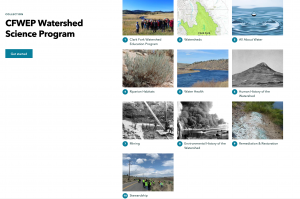
In March of 2020, CFWEP was gearing up for one of our busiest times of the year: spring field season. Every spring our staff gears up to teach our Watershed Science Program at schools throughout the watershed, visiting classrooms and leading field trips that educate students on the past and present restoration in their watershed and engages them with local hands-on science. But a week before the first week of Watershed Science Program, the COVID-19 pandemic hit Montana, and, like so many others, CFWEP’s plans had to change. With schools closing, in-classroom visits and field trips were no longer possible, and CFWEP spent the remainder of the spring supporting our teachers in their new virtual learning.
CFWEP recognized that the lasting effects of the COVID-19 pandemic are uncertain and that planning for the future, especially in education, lacked concrete answers. Would students be able to return to classrooms? If they did, would our staff be allowed into schools to teach lessons? What about the possibility of field trips? Our solution was to design a virtual curriculum that could adapt to the changing conditions in place because of the pandemic. When we began working on this virtual curriculum over the summer, we didn’t have the answers to any of these questions, but we wanted to be prepared for every possible scenario.
Our goal was to build a virtual curriculum that is interactive and able to support various types of media. We decided to use ArcGIS StoryMaps, a relatively new online software from ESRI, as our platform. StoryMaps allowed us to incorporate text, video, pictures, and maps in a way that could enrich a student’s experience with the curriculum. StoryMaps is also supported on various devices, including mobile phones and tablets, which we felt was important to ensure that students without reliable access to a computer would have other options to use the curriculum.
In building our virtual curriculum, we began by converting our traditional in-classroom curriculum directly into text and photo in the StoryMap. We quickly realized, though, that teaching methods we use in the classroom aren’t as effective without the staff there to present the material. In order to make the content flow and connect, a new approach was needed. We broke our curriculum into smaller pieces; rather than five lessons, we created ten. We made additional graphics to help students visualize topics that we would typically explain and answer questions about in person. We produced videos of our staff teaching different aspects of watershed science that bring voices from CFWEP into the lesson. We created interactive maps that allow students to explore their watershed. We included hyperlinks to reliable sources with more information so students interested in learning more about a subject could do so.
CFWEP created our virtual Watershed Science Program curriculum with the intent that teachers could use it in the way that best suits them and their students. In the worst-case scenario, if schools are forced to close again the curriculum can be navigated entirely by the students. But the StoryMaps can still be used by teachers if that doesn’t happen. If CFWEP staff is unable to enter school buildings, a limitation we are currently facing, teachers can use the StoryMaps in their classroom by going through it with their students or having their students go through it individually in a computer lab, using a laptop cart, or as an at-home assignment. This also allows students doing distance learning to access the same content as what is being taught in the classroom. In addition to the StoryMap, CFWEP has created supplemental materials including a guide to using the StoryMap and a journal that students work through as they are learning. Our hope is that these materials will accompany the StoryMap to allow teachers to access the Watershed Science Program curriculum in a way that is both effective and educational, no matter what the teaching circumstances look like.
Many things still remain uncertain, but CFWEP is committed to making adaptations to best support our teachers and students. We hope that our virtual curriculum serves as a trustworthy resource in a time where so much is unknown, though we can’t wait until we can safely return to engaging students in science learning in person.
CFWEP’s Watershed Science StoryMaps can be accessed here.
